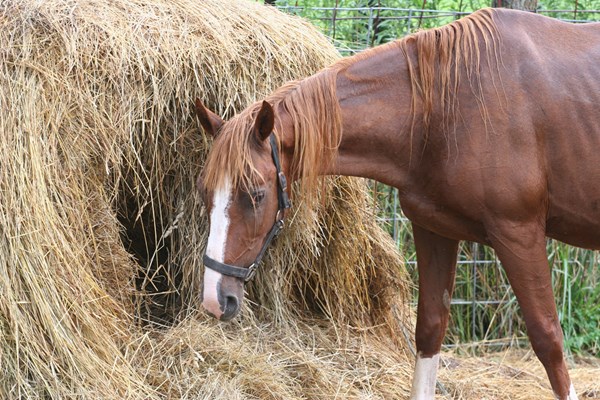 Credit: Thinkstock Use feeders for round or square bales to avoid wastage, keep hay off the ground and prevent horses from “eating the middle out” and having their respiratory systems bombarded by dust.
Credit: Thinkstock Use feeders for round or square bales to avoid wastage, keep hay off the ground and prevent horses from “eating the middle out” and having their respiratory systems bombarded by dust.Throwing hay on the ground typically creates a lot of wastage as the horses trample it into the dirt making it unpalatable and/or the wind blows loose hay away. Confining hay within a safe feeder can eliminate wastage by as much as 38%. This is significant when you consider the cost of hay in addition to the amount of work it takes to haul it, stack it, store it, and deliver it to the horses. Investing in a hay feeder can be worthwhile to recoup some of your expenses and labor.
There are a number of commercial hay feeders that are useful for square bales or round bales. Consider that many of these are designed for cattle and might be inappropriate for horse use due to the possibility of face or leg entrapment, rubbing on tender face skin with consistent use, or rubbing out mane hairs.
Round or square bale feeders take advantage of providing horses with free-choice hay as well as minimizing the degree of labor involved in taking hay to the field or paddock. Feeders that discourage a horse from fully sticking its face in the hay result in less wastage–the horse takes a mouthful, chews and eats it rather than pulling excess forage onto the ground where it is soiled or trampled and rendered unpalatable.
There are other advantages, as well, of using bale feeders:
- When throwing hay onto the ground for feeding, the collection of wasted hay/organic debris underfoot provides a breeding ground for insects, particularly if coupled with damp or wet conditions.
- Less hay wastage translates to better feed efficiency for the horses as well as economic savings for you, both in terms of reduced hay costs and reduced labor costs of cleanup.
- By not sticking their faces into the hay, the horses suffer fewer respiratory effects from lessening of inhaled dust.
- Eating from a feeder rather than off the ground reduces ingestion of dirt and sand, thus can reduce the incidence of colic related to that debris in the GI tract.
Whatever type of feeder you choose, keep in mind the health and safety of the horse in addition to the economics and logistics of your feeding program.


